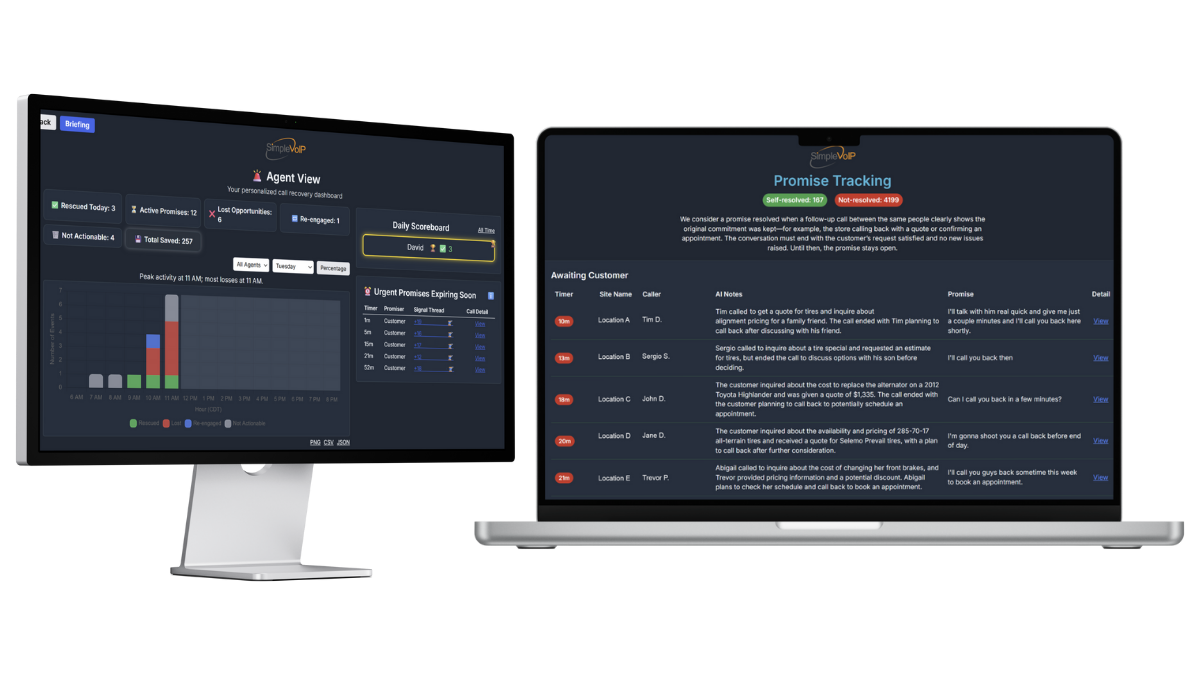When someone’s car breaks down, time matters. Whether they’re stuck in a parking lot, late for work, or just trying to make it to their kid’s soccer game, they’re not waiting long before dialing the nearest auto shop. One national automotive service provider knows this better than most. With over 500 locations across the country, they serve more than 2.8 million customers every year. That’s a lot of oil changes, tire rotations, and brake checks—and a lot of phone calls.
But not all those calls were being answered.
The Problem Hiding in Plain Sight
Before switching to SimpleVoIP, this multi-brand auto chain had limited visibility into how phone calls were handled at each store. Managers and employees were doing their best to juggle in-person customers and ringing phones, but without centralized analytics, no one knew just how many calls were going unanswered.
“We all assumed we were missing some calls,” said the company’s VP. “But we didn’t have a way to track them. There was no way to quantify how big the problem really was.”
And the problem was big. Once they implemented SimpleVoIP’s Dimensions Enhanced Analytics platform, the numbers became clear. They were losing close to 1,900 calls per week across their network. These weren’t cold leads or robocalls—these were high-intent customers actively trying to book service.
Finding a Fix That Made Sense
With better data came better decisions. SimpleVoIP’s Enhanced Call Analytics allowed the team to track metrics like ring time, abandonment rates, call volume by location, and response times. Patterns started to emerge. Stores that were especially busy in person were often the ones letting calls slip through the cracks.
Rather than expecting store staff to do the impossible—provide great in-person service while managing phones—they chose a smarter route.
They worked with SimpleVoIP to roll out a rollover strategy: if a call wasn’t answered after a few rings, it would automatically redirect to a centralized Business Development Center (BDC), where someone could assist the customer right away.
“We literally shifted our entire call strategy in under 30 days,” the VP said. “It was one of the smoothest transitions we’ve had. And the impact was immediate.”
Results You Can Trust
The week the new system went live, lost calls dropped dramatically—from nearly 1,900 to under 400. That’s over 1,500 additional customers each week who now had someone pick up the phone when they needed help.
In an industry where every call can lead to hundreds of dollars in service, the financial impact was significant.
The company didn’t want to put an exact number on it, but confirmed the results translated into a multimillion-dollar revenue shift.
“We always knew missed calls were an issue. But seeing the data and then fixing it—fast—changed everything,” the VP said.
The benefit wasn’t just about numbers either. The change improved customer experience, helped store staff focus on in-person service, and made the entire call-handling process more consistent across all locations.
Staying Agile Beyond the First Win
One of the key reasons the rollout worked so well was the flexibility and responsiveness of the SimpleVoIP team. The VP described the experience as highly collaborative, with constant back-and-forth idea sharing.
“SimpleVoIP isn’t just a vendor. I’ll bring up an idea in a meeting, and before we’re even off the call, someone has already confirmed they can make it happen,” they said.
That kind of back-end agility has helped the company continue to build on its early wins. They’ve begun exploring post-call automation, SMS follow-ups, and after-hours routing—all geared toward one simple goal: making sure no customer falls through the cracks.
And they’re not stopping there. With more data and more confidence, the team is now treating every phone call as an opportunity.
Why It Matters
For companies that depend on inbound phone calls, it’s easy to underestimate the cost of a missed one. Whether you’re a local service provider or a national brand, customers won’t always call back. Sometimes they move on. Sometimes they get frustrated. And sometimes, the moment passes and the sale is lost.
This story is proof that solving what seems like a small operational issue—missed calls—can have a massive payoff when tackled the right way.
It didn’t take a major system overhaul. It didn’t take six months of meetings. It took the right data, a willing team, and a fast-moving partner.
And that made all the difference
Interested in learning how SimpleVoIP can help you uncover and solve hidden communication gaps? Reach out to us to get started.




